Mary Anne Yarde's Blog: The Coffee Pot Book Club , page 170
September 20, 2018
Family Secrets: The Inspiration behind Rosemary in Bloom by Khristy Reibel #amwriting #Historical #Romance @KhristyReibel
Family Secrets: The Inspiration behind Rosemary in BloomBy Khristy Reibel

Every family has their share of characters—outrageous, mysterious, trouble-making, hilarious. Sometimes it isn’t what is said that is the most interesting. When I heard that my grandma wrote my grandfather a Dear John letter while he was fighting in Europe during World War II and married someone else, I had to know more! I wanted to know every detail that she could remember. After we had a few beers, she would reveal bits and pieces of her story. The more I heard, the more I wanted to know. She was fascinating. Sometimes, she would blow off my questions, feigning senility. I took those kernels that I got from her and expanded it into a novel, loosely based on her life.
 My grandmother.
My grandmother.The war years seems so romantic and much simpler. I wanted to show that it was neither romantic nor simple. I wanted to show the brutalities of war, fighting in Europe. I had no information about my grandfather’s experience in the war. Through the wonders of the internet, I found a book published by his infantry. When I saw his name in there listed as a Purple Heart recipient, I got goose bumps. I used this book as a guide for the movements of my grandpa in Luxembourg and Germany. I also wanted to highlight the patriotic actions of the people in my small town in Illinois. I went to the Streator Historical Society and gathered information about war bond drives, scrap metal drives, parades, the cantina at the train depot which served troops going to training. I wanted to honor the actions of my home town and remind people how they came together to fight for a common good. At its heart, this book is a love story, separated by war, pushed along by fear, and resolved through patience. I hope you enjoy the wild ride Rosemary takes you on!
 My grandparents.
My grandparents.Rosemary in Bloom- Inspired by a true story
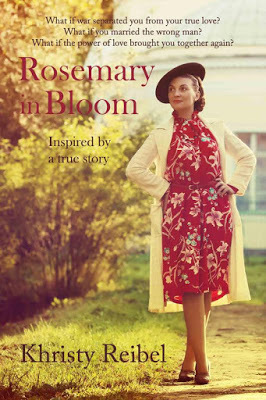 When Rosemary meets Albert, it is instant chemistry. But it is also the summer of 1942, and scores of young men—Albert included—feel compelled to enlist to fight the war against Hitler. Albert wants to marry Rosemary before he leaves for Europe, but she just can’t commit. Like so many young women of her time, Rosemary finds herself left behind to work and worry, desperate for love but frightened of abandonment.Three years later, and with Albert’s fate still unknown, Rosemary meets Harry, a charming and handsome man. Rosemary feels guilty for spending so much time with Harry, but she has lost all faith that Albert will make it home safely, especially when she receives news of her brother’s serious combat injury. Should she wait for Albert, or settle for the man in front of her?Inspired by a true story, Rosemary in Bloom explores faith, forgiveness, enduring love against all odds, and the difficult decisions that strong, smart women on the home front had to make during World War II.
When Rosemary meets Albert, it is instant chemistry. But it is also the summer of 1942, and scores of young men—Albert included—feel compelled to enlist to fight the war against Hitler. Albert wants to marry Rosemary before he leaves for Europe, but she just can’t commit. Like so many young women of her time, Rosemary finds herself left behind to work and worry, desperate for love but frightened of abandonment.Three years later, and with Albert’s fate still unknown, Rosemary meets Harry, a charming and handsome man. Rosemary feels guilty for spending so much time with Harry, but she has lost all faith that Albert will make it home safely, especially when she receives news of her brother’s serious combat injury. Should she wait for Albert, or settle for the man in front of her?Inspired by a true story, Rosemary in Bloom explores faith, forgiveness, enduring love against all odds, and the difficult decisions that strong, smart women on the home front had to make during World War II.Amazon UK • Amazon US
Khristy Reibel
 Khristy Reibel grew up in rural Illinois, the setting for most of the action in the novel. Even though she lives in Las Vegas now, she is still a Midwestern girl at heart. After graduating high school, she attended the University of Illinois, where she received a B.S. in Marketing, which enabled her to hone her writing skills by creating advertising copy for a tradeshow company. In 2008, she enrolled at UNLV and later graduated with an M.Ed. In addition to writing, she teaches high school English and German. She believes that teaching students to support their ideas in writing is the most important skill she can help them learn. This is her first novel published.
Khristy Reibel grew up in rural Illinois, the setting for most of the action in the novel. Even though she lives in Las Vegas now, she is still a Midwestern girl at heart. After graduating high school, she attended the University of Illinois, where she received a B.S. in Marketing, which enabled her to hone her writing skills by creating advertising copy for a tradeshow company. In 2008, she enrolled at UNLV and later graduated with an M.Ed. In addition to writing, she teaches high school English and German. She believes that teaching students to support their ideas in writing is the most important skill she can help them learn. This is her first novel published.
Published on September 20, 2018 23:00
September 19, 2018
Blog Tour and #Giveaway — Clash Of Empires by Paul Bennett #HistFic #Historical @hfvbt @hooverbkreview
Historical Fiction Virtual Book Tour Presents….

Clash Of Empires
By Paul Bennett

In 1756, Britain and France are on a collision course for control of the North American continent. The eventual result can be described as the first world war, known as the Seven Year’s War in Europe and the French and Indian War in the colonies. The Mallory family uproots from eastern Pennsylvania, and moves to the western frontier, where they find themselves in the middle of war. Daniel, Liam, and Liza (the three Mallory siblings) become involved in the conflict in ways that lead to emotional trauma for each. The story focuses on historical events and includes historical characters. Clash of Empires is an exciting look at the developments leading to the events of July 1776, which are chronicled in the sequel as we follow the exploits and fate of the Mallory clan.
“I feel both educated and thoroughly entertained by Mr. Bennett’s debut novel ‘Clash of Empires’. Rich in detail mined from the author’s clearly painstaking research, we find lessons that should have been learned from the distant past rising to the fore once more; cannons boom, bullets fly and tomahawks spin through the air as the war builds towards a brutal climax. A fresh voice and a cracking tale. Recommended!”
Author Gordon Doherty
Giveaway
During the Blog Tour we will be giving away a signed copy of Clash of Empires to one lucky reader! You can enter: HERE!
Giveaway Rules
• Giveaway ends at 11:59pm EST on October 12th. You must be 18 or older to enter.• Giveaway is open to US/Canada only.• Only one entry per household.• All giveaway entrants agree to be honest and not cheat the systems; any suspect of fraud is decided upon by blog/site owner and the sponsor, and entrants may be disqualified at our discretion.• Winner has 48 hours to claim prize or new winner is chosen.
AMAZON US • AMAZON UK • INDIEBOUND
Paul Bennett
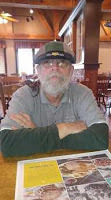 Paul’s education was of the public variety and when he reached Junior High he discovered that his future did not include the fields of mathematics or science. This was generally the case throughout his years in school as he focused more on his interest in history; not just the rote version of names and dates but the causes. Paul studied Classical Civilization at Wayne State University with a smattering of Physical Anthropology thrown in for good measure. Logically, of course, Paul spent the next four decades drawing upon that vast store of knowledge working in large, multi-platform data centers, and is considered in the industry as a bona fide IBM Mainframe dinosaur heading for extinction. Paul currently resides in the quaint New England town of Salem, Massachusetts with his wife, Daryl. The three children have all grown, in the process turning Paul’s beard gray, and have now provided four grandchildren; the author is now going bald.
Paul’s education was of the public variety and when he reached Junior High he discovered that his future did not include the fields of mathematics or science. This was generally the case throughout his years in school as he focused more on his interest in history; not just the rote version of names and dates but the causes. Paul studied Classical Civilization at Wayne State University with a smattering of Physical Anthropology thrown in for good measure. Logically, of course, Paul spent the next four decades drawing upon that vast store of knowledge working in large, multi-platform data centers, and is considered in the industry as a bona fide IBM Mainframe dinosaur heading for extinction. Paul currently resides in the quaint New England town of Salem, Massachusetts with his wife, Daryl. The three children have all grown, in the process turning Paul’s beard gray, and have now provided four grandchildren; the author is now going bald.For more information, please visit the Mallory Saga Facebook page. You can also find Paul on his Blog, Twitter, and Goodreads.
Published on September 19, 2018 23:00
September 18, 2018
Author's Inspiration — How my family history led me to become an author by Eamonn Ashe #amwriting #History #WWI @WorldWarBook
How my family history led me to become an author.By Eamonn Ashe
My grandfather was killed in the First World War. In 1991 I brought my mother (his daughter) to France to visit his grave. It was her first and only time to visit her father’s final resting place. I found the trip very poignant; however, I was surprised that my mother seemed stoical. On the way back to Paris I said to her, “Mam, I thought you would be more emotional.”She replied, “Eamonn, you don’t understand. I was born in 1915; my Dad was killed in the war in 1918 — during those three years, he was away at the war. I didn’t really know him.” I realised then that Mam was what I would call a war orphan and, bearing in mind that the total death toll between the two world wars was sixty million, I wondered then and still wonder how many war orphans there were. Sixty million people is the equivalent of every man, woman and child in Britain being killed.
My grandfather, Joseph Phillips, was a Company Sergeant with the Connaught Rangers. After enlisting in the army at Renmore Barracks in 1899, he served in the Boer War and later in India. He got married in India in 1907 and had five children: Myra, Phyllis (my mother), Bernie, Leo and Alby. When the First World War began in 1914, he was already an experienced soldier. He saw action on several of the world war fronts before being tragically killed in action in France at the age of thirty-six in what became known as the German Spring Offensive. The Russians had withdrawn from the war in 1917 after their own revolution, leaving the Germans with a clear field on the Eastern Front. They then concentrated their full attention on the Western Front in an attempt to finish the war before the Americans arrived. The Germans launched a major offensive on 21 March, taking full advantage of a very heavy fog. Joseph Phillips was one of many casualties. He is buried in Ste. Emilie Valley Cemetery, Villers-Faucon, Somme, France.
My visit to his grave was my first to a war cemetery. It made such an impression on me that I resolved to write a book about the Great War, which is remembered for the horrors of trench warfare that cost the lives of ten million soldiers. It decimated cities, destroyed countries and obliterated centuries-old empires. It was to be “the war to end all wars” yet just twenty years later the world was plunged into another even more devastating conflict. I became fascinated by the events which shaped Europe and the United States in the years that followed the First World War: the crucifying debt, the depressed state of countries and the enmity over territorial disputes. Following the signing of the Treaty of Versailles at the end of that war, British Economist John Maynard Keynes said, “I believe that the campaign for securing from Germany the general costs of the war was one of the most serious acts of political unwisdom for which our statesmen have ever been responsible.” This era facilitated the rise of Hitler and Stalin, two of the greatest mass-murderers this world has ever known. So decided to write a concise history of the two world wars and the interwar years. I called it ‘31 Years of Hell! 1914–1945’ to reflect the horrors of both world wars.
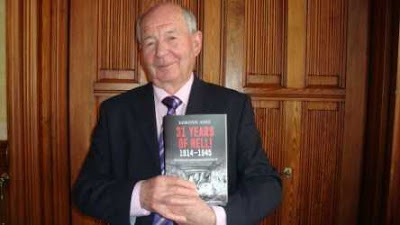
Eamonn Ashe with his critically-acclaimed book '31 Years of Hell! 1914–1945'
Once I had made the decision to write the book I realised that a huge amount of research was required so I read dozens of books and watched many documentaries about the wars. I also embarked on war tours to the Somme, Messines, Passchendaele, Gallipoli, Tyne Cot Cemetery and the Menin Gate (World War I) followed by the Normandy Beaches, Berlin, the site of the Dunkirk Evacuation (World War II) and the Imperial War Museum in London.
Once I commenced writing, I realised that I had to adopt a system. There were too many distractions during the daytime so I decided to write during the night and I quickly discovered that two hours writing at night was more productive than four hours during the day. This is a practice that has stayed with me.
Because there is so much detail involved in documenting the world wars, I decided to illustrate the book with maps which would show the vast territories involved and the power struggles therein. I also wrote timelines at the end of each chapter to give readers a snapshot of the key developments in a given year. To convey the emotion of this traumatic time in history, I have included powerful photographs which underscore the very human aspect to this global tragedy. I feel honoured that historian and author William Henry described the book as: "An excellent and riveting book” and that British security expert Philip Ingram MBE endorsed it as: “Brilliantly researched, clearly written, expertly edited. For a factually-based history book it reads as easily as a good novel.”
‘31 Years of Hell! 1914–1945’ tells the captivating story of the two world wars in a well-paced, easy-to-read narrative. It is a timely and moving account of power struggles, human suffering and the devastating toll of war. I have dedicated the book to my mother and it is one of my greatest pleasures to see it on bookshelves.
‘31 Years of Hell! 1914–1945’
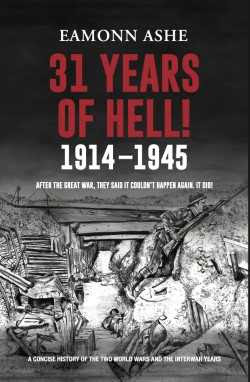 The First World War decimated cities, destroyed countries, obliterated empires and cost millions of lives. Yet only twenty years later the world was plunged into another even more devastating conflict. This book gives a compelling insight into how the terrible impact of World War I led to crucifying debt, enmity over territorial disputes and the brewing of unimaginable horrors in the cauldron of the interwar decades. '31 Years of Hell!' chronicles in a concise captivating narrative the entire turbulent period from 1914 to 1945. It is a timely and moving account of power struggles, human suffering and the devastating toll of war.
The First World War decimated cities, destroyed countries, obliterated empires and cost millions of lives. Yet only twenty years later the world was plunged into another even more devastating conflict. This book gives a compelling insight into how the terrible impact of World War I led to crucifying debt, enmity over territorial disputes and the brewing of unimaginable horrors in the cauldron of the interwar decades. '31 Years of Hell!' chronicles in a concise captivating narrative the entire turbulent period from 1914 to 1945. It is a timely and moving account of power struggles, human suffering and the devastating toll of war.Amazon US • Amazon UK• Book’s Website
Eamonn Ashe
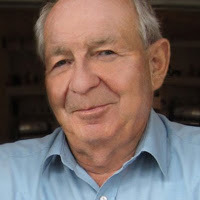 Eamonn Ashe made his debut as an author with his world war book ‘31 Years of Hell! 1914–1945’ Originally from Galway, he studied engineering and ran his own companies for more than thirty years. He became gripped by the world wars, sparked by the loss of his grandfather in World War I. Joseph Phillips, a Company Sergeant Major in the Connaught Rangers, died on the fields of France on 21 March, 1918 during Germany’s Spring Offensive. Eamonn became so passionate about the world wars that he resolved to write a book about them when he retired. An avid reader, Eamonn Ashe has studied dozens of books about the wars and the interwar years. He has deepened his insight through documentaries and visits to war sites, including:• Battlefields at the Somme, Messines and Passchendaele• War museums in Ypres and Albert• Sites of the Normandy landings• Allied war cemeteries at Tyne Cot (Passchendaele) and Normandy• Checkpoint Charlie• Brandenburg Gate• Soviet War Memorial (Tiergarten)• Battle of Berlin sites• Seelow Heights museum• Wannsee Conference building• Cape Helles, Anzac Cove and Suvla Bay in Gallipoli• Atatürk monument• Francis Ledwidge's graveWhen Albert II, Prince of Monaco visited Eamonn’s home town of Drogheda in 2017 the author was delighted to present him with a copy of his book ‘31 Years of Hell! 1914–1945’. He also sent a copy to the President of Ireland, Michael D. Higgins, who wrote to Eamonn expressing his interest in the book.
Eamonn Ashe made his debut as an author with his world war book ‘31 Years of Hell! 1914–1945’ Originally from Galway, he studied engineering and ran his own companies for more than thirty years. He became gripped by the world wars, sparked by the loss of his grandfather in World War I. Joseph Phillips, a Company Sergeant Major in the Connaught Rangers, died on the fields of France on 21 March, 1918 during Germany’s Spring Offensive. Eamonn became so passionate about the world wars that he resolved to write a book about them when he retired. An avid reader, Eamonn Ashe has studied dozens of books about the wars and the interwar years. He has deepened his insight through documentaries and visits to war sites, including:• Battlefields at the Somme, Messines and Passchendaele• War museums in Ypres and Albert• Sites of the Normandy landings• Allied war cemeteries at Tyne Cot (Passchendaele) and Normandy• Checkpoint Charlie• Brandenburg Gate• Soviet War Memorial (Tiergarten)• Battle of Berlin sites• Seelow Heights museum• Wannsee Conference building• Cape Helles, Anzac Cove and Suvla Bay in Gallipoli• Atatürk monument• Francis Ledwidge's graveWhen Albert II, Prince of Monaco visited Eamonn’s home town of Drogheda in 2017 the author was delighted to present him with a copy of his book ‘31 Years of Hell! 1914–1945’. He also sent a copy to the President of Ireland, Michael D. Higgins, who wrote to Eamonn expressing his interest in the book.Connect with Eamonn: Website • Facebook • Twitter.
Published on September 18, 2018 23:00
September 17, 2018
Blog Tour — Nothing is Forgotten by Peter Golden #ColdWar #Holocaust #historicalfiction @hfvbt @PeterGolden32
Historical Fiction Virtual Blog Tour presents…
Nothing is ForgottenBy Peter Golden

From the beloved author of Comeback Love and Wherever There Is Light, comes a novel about the life-changing journey of a young man who travels from New Jersey to Khrushchev’s Russia and the beaches of Southern France as he finds love and discovers the long-hidden secrets about his heritage.
In 1950s New Jersey, Michael Daniels launches a radio show in the storage room of his Russian-Jewish grandmother’s candy store. Not only does the show become a local hit because of his running satires of USSR leader Nikita Khrushchev, but half a world away, it picks up listeners in a small Soviet city.
There, with rock and roll leaking in through bootlegged airwaves, Yulianna Kosoy—a war orphan in her mid-twenties—is sneaking American goods into the country with her boss, Der Schmuggler.
But just as Michael’s radio show is taking off, his grandmother is murdered in the candy store. Why anyone would commit such an atrocity against such a warm, affable woman is anyone’s guess. But she had always been secretive about her past and, as Michael discovers, guarded a shadowy ancestral history. In order to solve the mystery of who killed her, Michael sets out to Europe to learn where he—and his grandmother—really came from.
Featuring Peter Golden’s signature “vivid characters and strong storytelling” (The Washington Post), Nothing Is Forgotten changes our understanding of the impact of World War II on its survivors and their descendants, and will appeal to fans of novels by Anita Diamant and Kristin Hannah.
“Golden draws a vivid portrait of the Cold War era, but it is the complex and unexpected connection between Holocaust survivors and their descendants that turns this book into a page-turner.” RT Book Reviews
“Nothing Is Forgotten is a Russian nesting doll of plot twists across continents and decades. This cleverly constructed Cold War tale, based on gripping true events, keeps readers eagerly anticipating what lies at its heart.”
Sarah McCoy, New York Times and international bestselling author of The Mapmaker’s Children
Amazon UK • Amazon US
Peter Golden
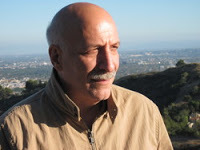 Peter Golden is an award-winning journalist, novelist, biographer, and historian. He lives outside Albany, New York, with his wife and son. He is the acclaimed author of the novels Comeback Love, Wherever There Is Light, and Nothing Is Forgotten.
Peter Golden is an award-winning journalist, novelist, biographer, and historian. He lives outside Albany, New York, with his wife and son. He is the acclaimed author of the novels Comeback Love, Wherever There Is Light, and Nothing Is Forgotten.For more information, please visit Peter Golden’s website. You can also connect with him on Facebook, Twitter, and Goodreads.
Published on September 17, 2018 23:00
September 16, 2018
Life in the time of… Colonel William Light by Virginia Taylor #History #Australia @authorVTaylor
Published on September 16, 2018 23:00
September 13, 2018
Book Spotlight — The Woolgrower’s Companion By Joy Rhoades #Australian #HistoricalFiction @joyrhoades1
The Woolgrower’s CompanionBy Joy Rhoades

Australia 1945. Until now Kate Dowd has led a sheltered life on her family's sprawling sheep station but, with her father's health in decline, the management of the farm is increasingly falling to her.Kate is rising to the challenge when the arrival of two Italian POW labourers disrupts everything – especially when Kate finds herself drawn to the enigmatic Luca Canali.Then she receives devastating news. The farm is near bankrupt and the bank is set to repossess. Given just eight weeks to pay the debt, Kate is now in a race to save everything she holds dear.
Excerpt
‘Mrs Dowd!’
Kate turned towards the voice, a man’s voice, from along the street. It was Mr Addison from the bank. Kate had always found him a bit snake-like, with heavy-lidded eyes behind thick glasses.
‘I’m sorry,’ he said, glancing to see who was about. ‘I wanted to catch you. To speak to you without your father. I’m sorry, I tell you.’
‘Sorry? What for?’
‘About Amiens. It’s a great shame.’
Kate stared at him.
‘I could give you a lift home, Mrs Dowd. I have a meeting in Wingadee this afternoon, anyway, and we could talk. Tell you how sorry I am.’
Kate needed to know what Addison was rabbiting on about. She pulled her door shut, and Addison reversed out, his cigarette smoke swirling about the car, and she wound her window all the way down.
As a blur of eucalyptus streamed by, Kate inhaled to ask Addison what he meant. ‘You’re sorry about what, Mr Addison?’
‘The Amiens debts. The overdue interest on the sheep property.’
‘Overdue? You’re mistaken,’ Kate said evenly. ‘My father always pays the bills.’
‘Incorrect. You’re overdue in the most serious way.’ He drew on the cigarette and blew the smoke over his shoulder out the window.
‘My father will be most unhappy that you’re saying these things.’
Addison brought the car to such a sudden stop off the bitumen, the wheels skidded in the dirt and Kate put a hand up against the wooden dashboard.
‘You don’t know,’ he said. ‘Know?’
She fought to stay calm. She would wonder later if it was at this moment that her old life ended.
Dust floated past the vehicle, sliced by the black myalls that lined the road. Addison flicked ash through his open window, let the clutch out and steered the car back onto the road. ‘You should know.’ He looked straight ahead and began to talk.
Available on Amazon
and all good book shops!
Joy Rhoades
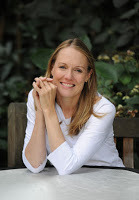 I grew up in a small town in the bush in Queensland, Australia. I spent my time with my head in a book, or outdoors – climbing trees, playing in dry creek beds, or fishing for yabbies in the railway dam under the big sky. Some of my favourite memories were visiting my grandmother’s sheep farm in rural New South Wales where my father had grown up. She was a fifth-generation grazier, a lover of history, and a great and gentle teller of stories. My childhood gave me two passions: a love of the Australian landscape and a fascination with words and stories.
I grew up in a small town in the bush in Queensland, Australia. I spent my time with my head in a book, or outdoors – climbing trees, playing in dry creek beds, or fishing for yabbies in the railway dam under the big sky. Some of my favourite memories were visiting my grandmother’s sheep farm in rural New South Wales where my father had grown up. She was a fifth-generation grazier, a lover of history, and a great and gentle teller of stories. My childhood gave me two passions: a love of the Australian landscape and a fascination with words and stories.I left the bush at 13 when I went to boarding school in Brisbane. I stayed on there to study law and literature at the University of Queensland. After, my work as a lawyer took me first to Sydney and then all over the world, to London, Hong Kong, Singapore, Tokyo and New York. But I always carried in my head a strong sense of my childhood: the people, the history, the light and the landscape. Those images have never left me and they would eventually become The Woolgrower’s Companion. It’s a story I’ve felt I had to tell.
I currently live in London with my husband and our two young children. But I miss the Australian sky.
Update: Joy’s debut novel has been shortlisted for the UK Society of Authors’ McKitterick Prize 2018 and shortlisted for the UK Historical Writers Association Debut Crown 2018.
Joy is active on social media and loves to engage with readers. Find her on Instagram, Facebook and Twitter
Published on September 13, 2018 23:00
September 12, 2018
The Island of Tin and King Arthur by Mary Anne Yarde #Cornwall #KingArthur #Legends
The Island of Tin and King ArthurBy Mary Anne Yarde
From the breathtaking beauty of the coast.
 The View from Tintagel Castle.
The View from Tintagel Castle. To the enduring Standing Stones whom for thousands of years have sat in watchful silence on Bodmin Moor.
 The Hurlers, Bodmin Moor.
The Hurlers, Bodmin Moor.Cornwall. A kingdom within a nation. A place where one step can take you on a journey the likes of which you could never imagine. This is a land of wild seas, myths and legends.
In the 6th Century, Cornwall was very much her own nation, just like she had always been. She was separated from the rest of mainland Britain by not only her language and her customs, but also by a spirit that refused to bow down to imposed authority. Whether that be Roman or Saxon.
My series, The Du Lac Chronicles, is set in war-torn South-West Britain, Brittany and Frank. But for today, I am going to talk about Cornwall, or the Kingdom of Cerniw, as she is known in my series.
Cornwall is my secret love affair. If I could choose to live anywhere in the world, it would probably be there. Not only does she have the most staggeringly beautiful countryside and sea, but her history is also something to admire, and her legends… Well, they are just my cup of tea.
 Penhale Sands.
Penhale Sands. Cornwall has an intriguing past. Now we all know that Emperor Hadrian built a huge wall to divide the North of the country from the South because the North was too wild to be conquered. But nothing is ever mentioned about the little kingdom in the far South-West of Britain. The Roman occupation of Cornwall is very intriguing. It has been suggested that the Roman's stopped at Devon. There are a few milestones and evidence of Roman occupation in Cornwall, but not on the scale of the rest of the county. Why? What was it about this little kingdom that stopped even the Roman Empire in its tracks?
Cornwall had something that the Roman’s wanted, and I think they kept their independence because they knew what they were doing when it came to commerce. In fact, Cornwall had something that everyone wanted. Tin. The history of mining for tin in Cornwall goes way back, far before the time of Winston Graham’s Poldark series. Cornwall was known as The Island of Tin. Silver has also been found in Cornwall. The land is rich with treasure for those who know where to look. And trade means money, and money… I heard that makes the world go round.
Fast-forward to the time when my books are set in, and once again Cornwall is standing strong against a foreign aggressor. Rome did not best her and nor would the Saxons.
I am fascinated by the Saxon invasion, and it is something that I explore in my series. In particular, I am interested in the Saxon, Cerdic of Wessex, and his journey to being crowned High King. While other kingdoms fell by the wayside and became incorporated into the Wessex realm, Cornwall held her ground. Cerdic landed in Hampshire in c.495. By 519, Cerdic had conquered the South of England, with the exception of Cornwall. It wasn't until the Battle of Hingston Down, in 838, when Cornwall finally lost her independence to the now vast Kingdom of Wessex. Cornwall repelled the Saxons for almost 350 years. Now, that is impressive.
 Dozemary Pool.
Dozemary Pool.As the water settles over Dozemary Pool and when the sun sets over the grass covered ruins of Castle Dore, it is easy to believe in the stories this land inspires. If King Arthur was not born at Tintagel Castle, then he should have been. If Arthur did not fall at Slaughter Bridge, then where did he? This is the land of King Arthur. This is the land where his reign began, and this is the land where it ended. If, you believe the stories that is.
Arthurian Legend and Cornwall have a relationship that spans over a thousand years. My series explores what happened after the death of King Arthur, and therefore Cornwall is a fundamental backdrop to my series.
The Du Lac Prophecy
(Book 4 of The Du Lac Chronicles)
Two Prophesies. Two Noble Households. One Throne.
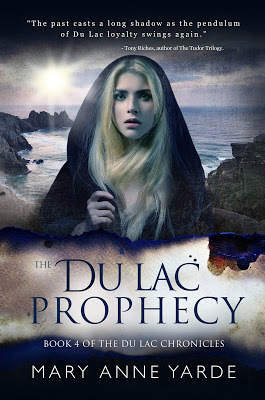 Distrust and greed threaten to destroy the House of du Lac. Mordred Pendragon strengthens his hold on Brittany and the surrounding kingdoms while Alan, Mordred’s cousin, embarks on a desperate quest to find Arthur’s lost knights. Without the knights and the relics they hold in trust, they cannot defeat Arthur’s only son – but finding the knights is only half of the battle. Convincing them to fight on the side of the Du Lac’s, their sworn enemy, will not be easy.
Distrust and greed threaten to destroy the House of du Lac. Mordred Pendragon strengthens his hold on Brittany and the surrounding kingdoms while Alan, Mordred’s cousin, embarks on a desperate quest to find Arthur’s lost knights. Without the knights and the relics they hold in trust, they cannot defeat Arthur’s only son – but finding the knights is only half of the battle. Convincing them to fight on the side of the Du Lac’s, their sworn enemy, will not be easy.If Alden, King of Cerniw, cannot bring unity there will be no need for Arthur’s knights. With Budic threatening to invade Alden’s Kingdom, Merton putting love before duty, and Garren disappearing to goodness knows where, what hope does Alden have? If Alden cannot get his House in order, Mordred will destroy them all.
Amazon US • Amazon UK • Amazon CA

Mary Anne Yarde
 Mary Anne Yarde is the multi award-winning author of the International Bestselling series — The Du Lac Chronicles.
Mary Anne Yarde is the multi award-winning author of the International Bestselling series — The Du Lac Chronicles.Yarde grew up in the southwest of England, surrounded and influenced by centuries of history and mythology. Glastonbury — the fabled Isle of Avalon — was a mere fifteen-minute drive from her home, and tales of King Arthur and his knights were a part of her childhood.
Mary Anne loves to hear from readers, you can find her: Media Links:Website/Blog • Facebook • Twitter • Amazon Author Page • Goodreads
Published on September 12, 2018 23:00
September 11, 2018
Author’s Inspiration ~ Margaret Porter, A Pledge of Better Times #amwriting #HistoricalFiction @MargaretAuthor
A Pledge of Better Times By Margaret Porter
I was a teenager. I remember the day being extremely warm. Normally my love of gardens would draw me outside, but England was suffering an abnormally hot summer, and the grandly baroque rooms of Hampton Court Palace were comparatively cool. In the King’s Private Dining Room I saw her. She was somewhat younger than the ladies in the other life-sized portraits ranged around the room, and prettier. In her hand she held an orange. In the lower left corner she was identified as the Duchess of St. Albans. Much later would I learn a great deal about the Hampton Court Beauties, painted by Godfrey Kneller at the request of Queen Mary II. On that stifling summer day, I only knew that I liked her picture best.
 The King’s Dining Room, Hampton Court. The inspiring portrait is on the left side.
The King’s Dining Room, Hampton Court. The inspiring portrait is on the left side.On return visits over many years, I was always drawn to that same portrait. To put it quite simply, I felt a connection.Some time later, the family genealogist provided me with a lengthy and detailed pedigree chart and a narrative. One section dealt with my de Vere forbears, and my eye lighted on a sentence stating that Lady Diana de Vere, heiress of the 20th and last Earl of Oxford, had married Charles Beauclerk, the first Duke of St Albans, the son of King Charles II by actress Nell Gwyn. I realized two things at once—this was the lady of the portrait, and I appeared to be related to her.I was under contract to my publisher for one or two more books, definitely not in search of an out-of-genre project. But from the start of my career I had aspired to write biographical fiction, and Lady Diana was a potential subject. But I needed to know more about her life.Over many years, after long hours in the British Library and the London Metropolitan Archive (where the Beauclerk family records reside) and many other places, I was able to piece together her story and that of her soldier husband, a royal bastard, and her courtier father and the queen in whose household she served. I visited and re-visiting the places she knew and lived in—Hampton Court Palace, Kensington Palace, Bestwood Park near Nottingham. In Windsor, I visited the site of her mansion (many times) and received permission to enter the private chapel where she was laid to rest at the end of her long life. I discovered two unknown portraits of her, also by Godfrey Kneller, and one of her husband. I became acquainted with and corresponded with their descendants.
 On the Street Where She Lived, Margaret in Windsor.
On the Street Where She Lived, Margaret in Windsor. In that era—and all others—men’s lives were documented in greater detail than women’s, so I was able to trace her duke’s history and movements. Although I discovered everything I possibly could about Diana, there were so many gaps. As a historian, I was often frustrated. As a novelist, I was grateful—my imagination and informed speculation are reliable and essential tools. To fill in blank spaces in my protagonist’s history, I shared something of myself. I gave her a dog modelled on one of mine. One of my favourite flowers, Passiflora incarnata, is also hers. Because she was one of Queen Mary’s attendants, and there was ample information about the daily activities of the royal retinue, I knew Diana had to be proficient in needlework and appreciative of gardens and fond of walking.When the time came for cover art decisions, I was adamant that the Hampton Court portrait be used. As a bystander to the involved process of obtaining the reproduction rights, I never lost hope. The Royal Collection, on behalf of Her Majesty the Queen, assented to the request.To my delight and relief, the initial inspiration for my novel is indeed featured on its cover, many years after it enthralled my teenaged self.
 Margaret with Lady Diana de Vere’s portrait, Hampton Court Palace.
Margaret with Lady Diana de Vere’s portrait, Hampton Court Palace.A Pledge of Better Times
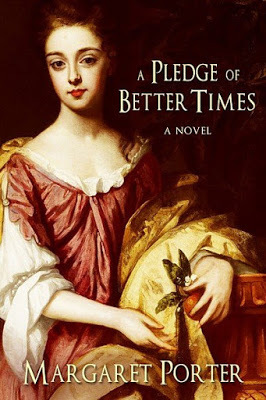 “Porter’s ambitious novel of 17th-century England is brimming with vivid historical figures and events . . . rigorously researched and faithfully portrayed.” ~ ~ Publishers Weekly“The remarkable figure of Lady Diana de Vere stands at the center of Margaret Porter’s sumptuous, wonderful new novel.” ~ ~ Historical Novels Review
A sweeping tale of ambition, treachery, and passion incorporating 17th century historical figures, royalty, and events.
For generations Lady Diana de Vere’s family loyally served England’s crown. But after King Charles II’s untimely death, her father firmly opposes James II’s tyranny. Charles Beauclerk, Duke of St. Albans—the late king’s bastard son by actress Nell Gwyn—also rebels against his newly crowned uncle’s manipulation.Political and religious turmoil bring revolution and yet another coronation before Charles returns to from war to claim his promised bride. As companion to Queen Mary Stuart, Diana has followed her de Vere forbears into royal service. She expects Charles to abandon his military career after marriage, but he proves unwilling to join the ranks of the courtiers he despises and mistrusts.In palace corridors and within their own household the young duke and duchess confront betrayals, scandals, and tragedies that threaten to divide them. And neither the privileges of birth nor proximity to the throne can ensure their security, their advancement—or their happiness.
“Porter’s ambitious novel of 17th-century England is brimming with vivid historical figures and events . . . rigorously researched and faithfully portrayed.” ~ ~ Publishers Weekly“The remarkable figure of Lady Diana de Vere stands at the center of Margaret Porter’s sumptuous, wonderful new novel.” ~ ~ Historical Novels Review
A sweeping tale of ambition, treachery, and passion incorporating 17th century historical figures, royalty, and events.
For generations Lady Diana de Vere’s family loyally served England’s crown. But after King Charles II’s untimely death, her father firmly opposes James II’s tyranny. Charles Beauclerk, Duke of St. Albans—the late king’s bastard son by actress Nell Gwyn—also rebels against his newly crowned uncle’s manipulation.Political and religious turmoil bring revolution and yet another coronation before Charles returns to from war to claim his promised bride. As companion to Queen Mary Stuart, Diana has followed her de Vere forbears into royal service. She expects Charles to abandon his military career after marriage, but he proves unwilling to join the ranks of the courtiers he despises and mistrusts.In palace corridors and within their own household the young duke and duchess confront betrayals, scandals, and tragedies that threaten to divide them. And neither the privileges of birth nor proximity to the throne can ensure their security, their advancement—or their happiness.Amazon UK • Amazon US • Kobo• Waterstones• Barnes and Nobel
Margaret Porter
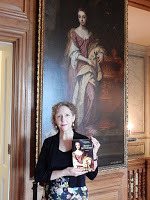 MARGARET PORTER is the author of A Pledge of Better Times and eleven more British-set historical novels for various publishers, including several bestsellers, award-winners, and many foreign language editions. She studied British history at universities in the U.K. and U.S., and afterwards worked in theatre, film and television.
MARGARET PORTER is the author of A Pledge of Better Times and eleven more British-set historical novels for various publishers, including several bestsellers, award-winners, and many foreign language editions. She studied British history at universities in the U.K. and U.S., and afterwards worked in theatre, film and television.You can find Margaret: Website • GoodReads • Twitter
Published on September 11, 2018 23:00
September 10, 2018
In their own words: The Lydiard Chronicles. #amwriting #HistoricalFiction #TowerOfLondon @ElizStJohn
In their own words: The Lydiard Chronicles.Writing historical fiction from my family’s letters, diaries and papers.

By Elizabeth St.John
“It was on the 29th day of January, in the year of our Lord 1619–20, that in the Tower of London, the principal city of the English isle, I was about four of the clock in the morning, brought forth to behold the ensuing light. My father was Sir Allen Apsley, lieutenant of the Tower of London; my mother, his third wife, was Lucy, the youngest daughter of Sir John St. John, of Lydiard Tregoze, in Wiltshire.”
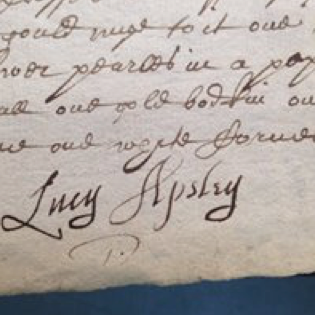
An extract from a Chancery Court pleading from 1635, sworn by Lucy Apsley
I read this entry many years ago for the first time in Lucy Hutchinson’s Memoirs of the Life of Colonel Hutchinson archived in Nottingham Castle and I was hooked. Not only was this a period of history that I found fascinating, this woman was for some reason born in the Tower of London—and her mother was an ancestor of mine. Lucy Apsley Hutchinson’s autobiography is just a fragment within her rich Memoirs, but was enough to fire my imagination. I continued reading (and her writing was remarkably clear and well-preserved) and got a shiver of excitement when I realized the extent of the story that was emerging. Here Lucy continues to describe her mother:“She was of a noble family, being the youngest daughter of Sir John St. John, of Lidiard Tregooze in the county of Wilts; her father and mother died when she was not above five years of age,
The Lieutenant’s House within the Tower of London, birthplace of Lucy Hutchinson.
The Tower of London, an orphan and a wicked stepmother. Now I was truly hooked. And so began my journey reconstructing the characters in my first novel, The Lady of the Tower. Determined to stay true to the story of Lucy St.John so faithfully penned by her daughter, I committed to only using primary sources for the evidence of their lives, and to weave the fiction between the facts. So rich a resource is Lucy Hutchinson’s Memoirs, I continued to use it as the inspiration for my second novel in The Lydiard Chronicles, the Civil War epic By Love Divided. Now, as I embark on the third and final book in this particular series, Lucy’s words and observations are echoing clearly through the centuries, informing and animating the story of my ancestors four hundred years ago.
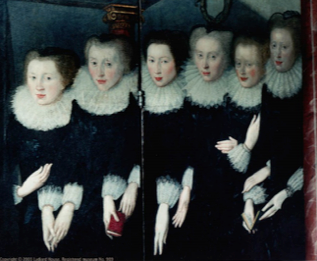
A full-size portrait of Lucy St.John and her five sisters at St. Mary’s Church, Lydiard Park.
Lydiard Park, Lucy’s ancestral home in Wiltshire, has always been a place I’ve loved to visit, and the portraits there of Lucy’s brother John, his wife (Lucy’s best friend) Anne, and her sister Barbara are quite lovely. And, of course, the unique and priceless polyptych in the Church of St. Mary’s with its unique portrait of all six sisters is any writer’s dream. Now I could put faces to the words.Researching for my novel was a long and complicated journey to embark on. I visited the National Archives, combed scholarly sources on line and spent countless hours transcribing wills, court documents, letters and other written evidence. Every so often, there would be such an exciting find – a letter that mentioned Will St.’s pirating escapade, or a family tree that depicted Barbara’s children marrying Theo’s, that I’d jump for joy and rush to share the news with my bewildered family. Most poignant was one of the first original documents I found in the British Library – Sir Allen Apsley’s will, which forms the pivot for the story. Touching his signature, I felt such an emotional connection to Lucy St.John and all that she was to him, and how much he loved her. Here’s a heart wrenching and loving extract from his will and testament:
“If my deare wife (unto whom never man was more bound) take any distast I doe earnestly entreat her to forgive mee and I desire all the world should know that shee is a religious and vertuous lady a most kind wife.”In those days, writing a will was also an opportunity to make peace with God and Sir Allen Apsley’s Calvinist testament clearly afforded him the means to make his apology.
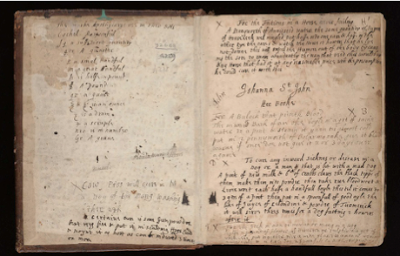
The front page of Lady Johanna St.John’s Receipt Book, originating in 1672.
I was also able to include many medicinal recipes within The Lady of the Tower (Lucy was documented as an herbalist who treated the prisoners of Tower with her curatives) that originate from Lady Johanna St.John’s Recipe Book, which is part of the Wellcome Foundation collection in London. Lady Johanna was Lucy’s niece by marriage, and since so many recipes were handed down and exchanged, I felt it was no stretch of the imagination to think some may have been Lucy’s.I am truly fortunate that my family is one that left its mark on the pages of English history. In more ways than one following their paper trail, discovering their portraits and walking through the rooms they once inhabited has been a discovery of my own heritage and life. And as I’ve married my passion for history and joy of writing, I’m always conscious of the ties that bind me back to these people that lived so long ago, their words and deeds, and whose lives I now share with my readers.The Lady of the Tower
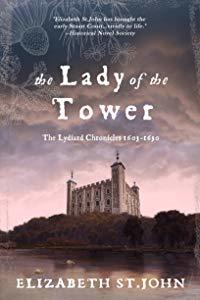
Orphaned Lucy St.John, described as "the most beautiful of all," defies English society by carving her own path through the decadent Stuart court. In 1609, the early days of the rule of James I are a time of glittering pageantry and cutthroat ambition, when the most dangerous thing one can do is fall in love . . . or make an enemy of Frances Howard, the reigning court beauty.
Lucy catches the eye of the Earl of Suffolk, but her envious sister Barbara is determined to ruin her happiness. Exiling herself from the court, Lucy has to find her own path through life, becoming mistress of the Tower of London. Riding the coattails of the king’s favorite, the Duke of Buckingham, the fortunes of the St.Johns rise to dizzying heights. But with great wealth comes betrayal, leaving Lucy to fight for her survival—and her honor—in a world of deceit and debauchery.
Elizabeth St.John tells this dramatic story of love, betrayal, family bonds and loyalty through the eyes of her ancestor Lucy and her family’s surviving diaries, letters and court papers.
By Love Divided
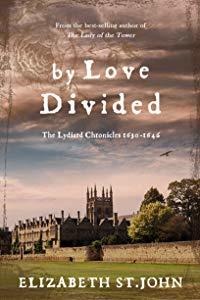 Fiercely independent, Luce Apsley rejects the dazzling English court and an entitled marriage arranged by her aristocratic family, and falls in love with a Roundhead soldier. Her mother follows the Puritan cause and yet her beloved brother, Sir Allen Apsley, chooses to fight for king and country. As England falls into bloody civil war, Luce embraces Parliament's radical views and confronts the very core of the family's beliefs. And when their influential Villiers cousins raise the stakes, King Charles demands loyalty. Allen and Luce face a devastating challenge. Will war unite or divide them? In the dawn of rebellion, love is the final battleground.
Fiercely independent, Luce Apsley rejects the dazzling English court and an entitled marriage arranged by her aristocratic family, and falls in love with a Roundhead soldier. Her mother follows the Puritan cause and yet her beloved brother, Sir Allen Apsley, chooses to fight for king and country. As England falls into bloody civil war, Luce embraces Parliament's radical views and confronts the very core of the family's beliefs. And when their influential Villiers cousins raise the stakes, King Charles demands loyalty. Allen and Luce face a devastating challenge. Will war unite or divide them? In the dawn of rebellion, love is the final battleground. Based on surviving memoirs, court papers and letters of Elizabeth St.John's family, By Love Divided continues the story of Lucy St.John, The Lady of the Tower. This powerfully emotional novel tells of England's great divide, and the heart-wrenching choices one family faces.
COUNTERPOINT: Theo, Earl of Suffolk
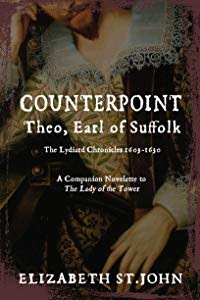 Theo Howard, Earl of Suffolk is torn. Betrothed to a child to satisfy his family dynasty, he longs for the freedom to make his own choice. And when he attends a lavish party at his family's newly-restored palace, he is immediately attracted to Lucy, a beautiful young lavender-seller. But in this enchanted world of Shakespeare's Midsummer's Night Dream, all is not as it appears. Theo's headstrong sister Frances is determined to sabotage her own arranged marriage, and aided by the cunning of Frances and her friend Barbara St.John, perhaps Theo can find his own path to happiness and true love.
Theo Howard, Earl of Suffolk is torn. Betrothed to a child to satisfy his family dynasty, he longs for the freedom to make his own choice. And when he attends a lavish party at his family's newly-restored palace, he is immediately attracted to Lucy, a beautiful young lavender-seller. But in this enchanted world of Shakespeare's Midsummer's Night Dream, all is not as it appears. Theo's headstrong sister Frances is determined to sabotage her own arranged marriage, and aided by the cunning of Frances and her friend Barbara St.John, perhaps Theo can find his own path to happiness and true love.When I wrote The Lady of the Tower, the story revealed itself in the narrative of my ancestress, Lucy St.John. But, as with all novels, other characters appeared, and their voices grew strong and insistent, demanding their own story be told. This novellete is Theo’s counterpoint to chapter six in the novel, in which Theo meets and falls in love with Lucy St.John.
A counterpoint is a melody played in conjunction with another, or an opposing viewpoint in an argument. Our lives are complex, and each one of us carries within us a counterpoint to another’s story. Here is one to Lucy St.John, the lady of the Tower.
COUNTERPOINT: Barbara, Lady Villiers
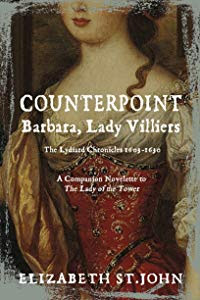 Barbara Villiers Palmer is one of the most famous courtesans in history. Mistress to Charles II and mother of five of his children, Lady Castlemaine's notoriety is legendary. This is the story of her namesake and grandmother, Barbara St.John Villiers. The apple did not fall far from the tree.
Barbara Villiers Palmer is one of the most famous courtesans in history. Mistress to Charles II and mother of five of his children, Lady Castlemaine's notoriety is legendary. This is the story of her namesake and grandmother, Barbara St.John Villiers. The apple did not fall far from the tree.Barbara St.John Villiers has always despised her sister Lucy, and when Theo Howard, Earl of Suffolk, fell in love with her, Barbara thought she'd die of jealousy. Instead, she decided to get even by befriending someone even more scandalous than herself, Theo's sister, Frances Howard, Countess of Somerset. Unfortunately, Frances was then imprisoned in the Tower of London, accused of murder, and Barbara had to find a way to turn this to her advantage - and continue her vendetta against Lucy.
When I wrote The Lady of the Tower, the story revealed itself in the narrative of my ancestress, Lucy St.John. But, as with all novels, other characters appeared, and their voices grew strong and insistent, demanding their own story be told. This novellete is Barbara’s counterpoint to chapter thirty-one in the novel, in which Barbara manipulates Theo and his sister to gain much for herself.
A counterpoint is a melody played in conjunction with another, or an opposing viewpoint in an argument. Our lives are complex, and each one of us carries within us a counterpoint to another’s story. Here is one to Lucy St.John, the lady of the Tower.
Amazon
Elizabeth St.John
 Elizabeth St.John was brought up in England and lives in California. To inform her writing, she has tracked down family papers and residences from Nottingham Castle, Lydiard Park, and Castle Fonmon to the Tower of London. Although the family sold a few castles and country homes along the way (it's hard to keep a good castle going these days), Elizabeth's family still occupy them - in the form of portraits, memoirs, and gardens that carry their imprint. And the occasional ghost. Elizabeth’s debut novel, The Lady of the Tower, has been an Amazon best seller since its release in 2016, and has won numerous awards for historical fiction. By Love Divided, the second in The Lydiard Chronicles series, follows the fortunes of the St.John family during the English Civil War, and was featured a the 2018 Swindon Festival of Literature as well as recognized with an “Editors’ Choice” by the Historical Novel Society. Elizabeth’s currently working on the next in the series, telling of the lives of the St.John women after the Civil War and into the Restoration.
Elizabeth St.John was brought up in England and lives in California. To inform her writing, she has tracked down family papers and residences from Nottingham Castle, Lydiard Park, and Castle Fonmon to the Tower of London. Although the family sold a few castles and country homes along the way (it's hard to keep a good castle going these days), Elizabeth's family still occupy them - in the form of portraits, memoirs, and gardens that carry their imprint. And the occasional ghost. Elizabeth’s debut novel, The Lady of the Tower, has been an Amazon best seller since its release in 2016, and has won numerous awards for historical fiction. By Love Divided, the second in The Lydiard Chronicles series, follows the fortunes of the St.John family during the English Civil War, and was featured a the 2018 Swindon Festival of Literature as well as recognized with an “Editors’ Choice” by the Historical Novel Society. Elizabeth’s currently working on the next in the series, telling of the lives of the St.John women after the Civil War and into the Restoration.Elizabeth loves to hear from readers, you can find her: Website, Amazon Author Page, Twitter, Facebook
Published on September 10, 2018 23:00
September 9, 2018
Storming the conventions of Historical Fiction by Derek Birks #amwriting #HistoricalFiction @Feud_writer
Storming the conventions of Historical FictionBy Derek Birks

I came late to writing historical fiction – in fact late to writing altogether.History was what I knew best but there were a number of conventions associated with historical fiction that I did not like very much.The idea of fictional history where one twisted the events and timeline to suit the story really didn’t appeal to me at all. The history was just too important to me. So if I was going to write historical fiction then whatever history I included would have to be as accurate as possible.Another, equally important consideration on my mind was readership. When I started writing, historical fiction tended to fall into one of two categories: historical romance, often written by women for women, and historical action, often written by men for men. Now I know this was not exclusively the case but it was pretty much so, as is evidenced by the number of female writers who used only their initials when writing books with a lot of action in them to disguise the fact that they were women. Obviously the publishing premise was that none of us have the remotest idea about the opposite sex! I found this convention rather irritating and I set out to write a book with three main protagonists: two women and one man. There would be plenty of action – no holds barred - but it wasn’t only the men who took part in it. There was some romance – in fact several love stories – but it was not the main theme.Overall there were as many female characters as male since my observation is that there are a lot of both in the world.There was another historical social convention I wanted to attack: the belief that women in the middle ages had no power, no influence and were simply there to have children. Now, whilst that might accurately represent the view of the medieval church, it is not in fact how life was. There were plenty of exceptions where women had considerable influence, ran their own businesses, and even commanded men. It seemed important to me that women were given a variety of roles in my stories: most conventional, but some not so conventional.Finally, I wanted to challenge the notion of the lower classes only ever acting in a supporting role. There is a place in the story for the plucky, loyal servant who sacrifices himself in order that the hero can survive but they weren’t all like that! I included the usual suspects: servants, innkeepers, whores, blacksmiths, yes – but I wanted them to have their own stories too, interwoven with their social superiors rather than just acting as stereotypes. I wanted therefore at least a little bit of social depth. How did the actions of the powerful impact on the lives of the not so powerful? I wanted subplots which dealt with their concerns – often very different from their masters. Some were loyal but others were grumpy and uncooperative despite - or because of - their lowly station in life. In fact the whole idea of characters being completely ‘good’ or ‘bad’ was something I was keen to move away from.The period covered by my first book Feud, 1459-61, was by far the bloodiest time of the Wars of the Roses and I felt that the reader needed to grasp exactly what that meant, so there is full-on action in several battles. But there were also the effects of battles which are less frequently dealt with. At the time I was writing Feud, I was intrigued by the discovery of some skeletons near the site of the battle of Towton. In itself, I suppose, it is not that surprising to find some corpses near an old battlefield but it was one skeleton in particular that interested me. One of the corpses revealed that this particular soldier, though he died at Towton, had received a grievous facial injury at some time well before that. It set me to thinking about battlefield surgery and how injured combatants dealt with life afterwards. The consequence of all my good intentions was that I ended up with a legion of characters. With hindsight I might have reduced the cast list a bit… but fortunately during the Wars of the Roses I could indulge in quite a few casualties…The danger in writing a story to appeal to both sexes was that I would alienate all readers: perhaps there was not enough romance, or too much action, or simply too many characters! My antidote for all of that was to make the pace of the story as fast as possible with a lot of dialogue and very few lengthy descriptions. I wanted the reader to keep reading – to be prepared to wade through the carnage – or the tender embraces - to find out what happened to the characters next.I am not suggesting that my series of books will appeal to everyone because I’m certain they will not – and that is as it should be. However, I have had enough direct contact with readers now – six years after I first published Feud – to be sure that, whatever flaws my debut novel had, it does have a lot of readers of both sexes who have enjoyed it.Since I began writing - some ten to twelve years ago now – the face of historical fiction has changed as society has changed. But, more importantly, publishing has changed too. The books ‘out there’ for readers now are no longer channelled only through traditional publishing and so there is a much greater variety of stories and sub-genres available.I’m not claiming here to have single-handedly broken any mould, just explaining what inspired me to write in the way I have. Now I am writing my seventh book and the principles I adopted at the start are still there – though hopefully my writing has improved over the years.My sixth, and most recent, Wars of the Roses novel, The Blood of Princes , is set in one of the most turbulent years in the whole of English history – 1483. And yes, it deals with Richard III and the Princes in the Tower, but, like all the books which preceded it, it is a story of a family – its men, women, children, servants, men at arms, etc. thrust into a time of crisis and trying – each in their own way – to emerge from it unscathed. As the blurb tells you: “… members of the battle-scarred Elder family are drawn, one by one, into his conspiracy. Soon they are mired so deep in the murky underbelly of London society, that there seems no hope of escape from the tangle of intrigue and murder.” But don’t worry, they’re getting used to it…
The Blood of Princes

A savage tale of love, treason and betrayal.A bloody struggle for power at the heart of the royal court.
In April 1483, the sudden death of King Edward IV brings his twelve year old son to the throne.Restless young lord and ex-mercenary John Elder is newly-appointed to the service of Edward, Prince of Wales, and charged with the boy’s safety. His first task, escorting the new king to London for his coronation, seems a simple one but the accession of a boy king raises concerns among the leading noblemen of the land. As old jealousies and feuds are rekindled, the new king’s uncle, Richard, Duke of Gloucester, seizes control and plunges the kingdom into crisis. But is Gloucester young Edward’s enemy, or saviour?While John, outlawed and trapped, must wait to see how events unfold, other members of the battle-scarred Elder family are drawn, one by one, into his conspiracy. Soon they are mired so deep in the murky underbelly of London society, that there seems no hope of escape from the tangle of intrigue and murder.In the end, all lives will hang upon the outcome of a daring incursion into the Tower of London itself.
Amazon US • Amazon UK
Derek Birks
 Derek was born in Hampshire in England but spent his teenage years in Auckland, New Zealand, where he still has strong family ties. On his return to England, after eight years abroad, he read history at Reading University.As long as he can remember, Derek has loved books and he always wanted to write. By the age of 17, he was writing stories, songs, poetry – in fact virtually anything. Inevitably, after university, work and family life took precedence and for many years he taught history in a secondary school. Though he enjoyed teaching immensely, he also found a creative outlet in theatrical activities: stage-managing musicals and outdoor Shakespeare, including a performance of Henry VIII for the Queen’s Silver Jubilee in 1977 at Windsor Castle.In 2010 Derek took early retirement to concentrate on writing. He aims to write action-packed fiction, rooted in accurate history. Though he is interested in everything historical, his particular favourite is the late medieval period. So far he has completed one 4-book series, entitled
Rebels and Brothers
, which is set during the Wars of the Roses and he is now midway through another Wars of the Roses series:
The Craft of Kings
which began with
Scars from the Past.
‘As with all good historical fiction, the reader learns fascinating period detail while being entertained by an experienced author who knows his trade.’ Historical Novel Society review of
Scars from the Past
Apart from his writing, he enjoys travelling – often to carry out research for his books - and also spends his time gardening, walking and taking part in archaeological digs.
Derek was born in Hampshire in England but spent his teenage years in Auckland, New Zealand, where he still has strong family ties. On his return to England, after eight years abroad, he read history at Reading University.As long as he can remember, Derek has loved books and he always wanted to write. By the age of 17, he was writing stories, songs, poetry – in fact virtually anything. Inevitably, after university, work and family life took precedence and for many years he taught history in a secondary school. Though he enjoyed teaching immensely, he also found a creative outlet in theatrical activities: stage-managing musicals and outdoor Shakespeare, including a performance of Henry VIII for the Queen’s Silver Jubilee in 1977 at Windsor Castle.In 2010 Derek took early retirement to concentrate on writing. He aims to write action-packed fiction, rooted in accurate history. Though he is interested in everything historical, his particular favourite is the late medieval period. So far he has completed one 4-book series, entitled
Rebels and Brothers
, which is set during the Wars of the Roses and he is now midway through another Wars of the Roses series:
The Craft of Kings
which began with
Scars from the Past.
‘As with all good historical fiction, the reader learns fascinating period detail while being entertained by an experienced author who knows his trade.’ Historical Novel Society review of
Scars from the Past
Apart from his writing, he enjoys travelling – often to carry out research for his books - and also spends his time gardening, walking and taking part in archaeological digs. Derik loves to hear from readers, you can find him: Website • Blog • Amazon Author Page• Facebook • Twitter.
Published on September 09, 2018 23:00
The Coffee Pot Book Club
The Coffee Pot Book Club (formally Myths, Legends, Books, and Coffee Pots) was founded in 2015. Our goal was to create a platform that would help Historical Fiction, Historical Romance and Historical
The Coffee Pot Book Club (formally Myths, Legends, Books, and Coffee Pots) was founded in 2015. Our goal was to create a platform that would help Historical Fiction, Historical Romance and Historical Fantasy authors promote their books and find that sometimes elusive audience. The Coffee Pot Book Club soon became the place for readers to meet new authors (both traditionally published and independently) and discover their fabulous books.
...more
...more
- Mary Anne Yarde's profile
- 159 followers



